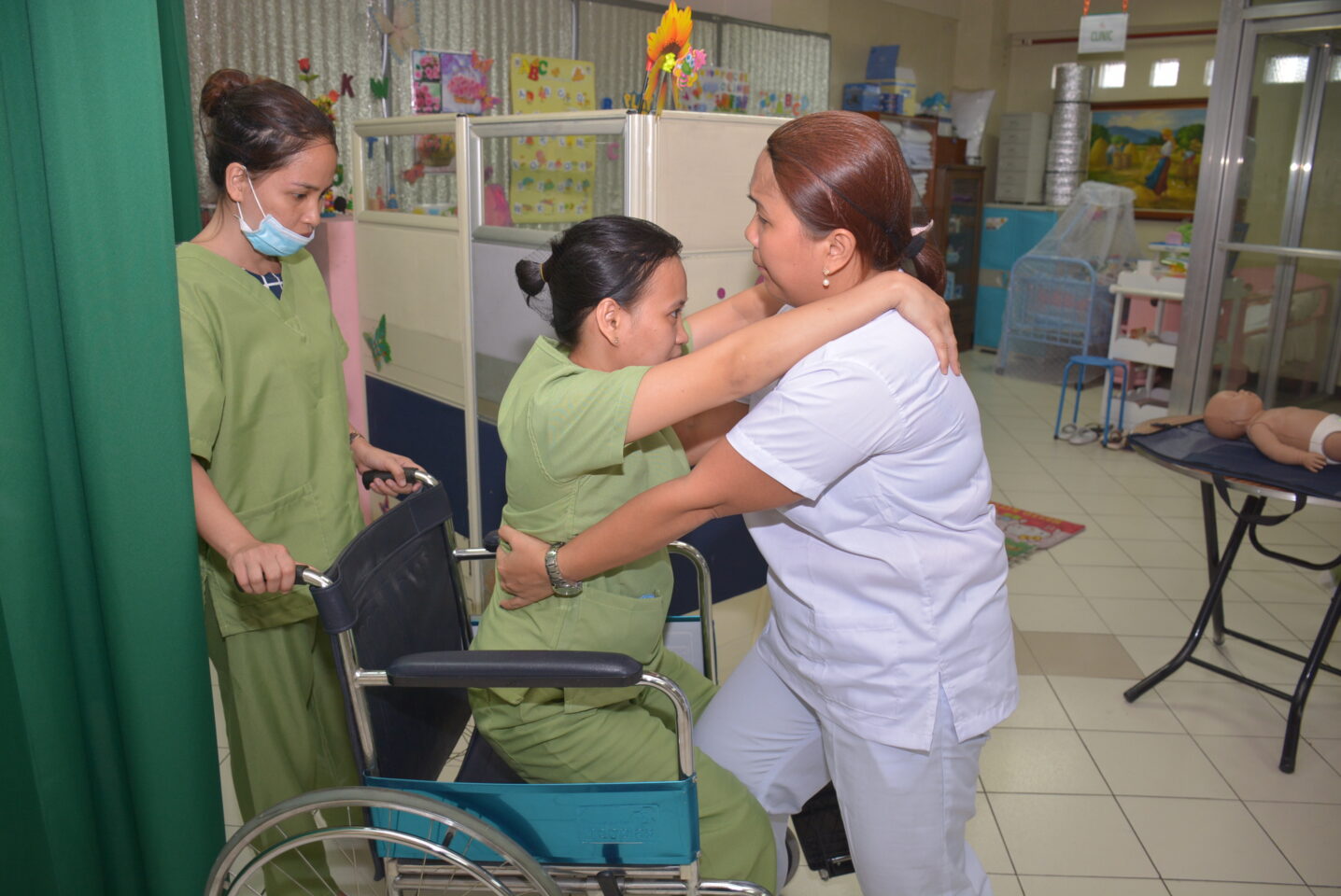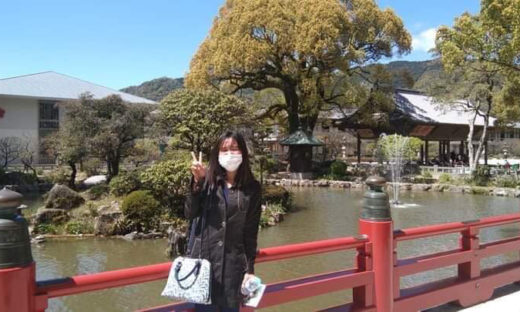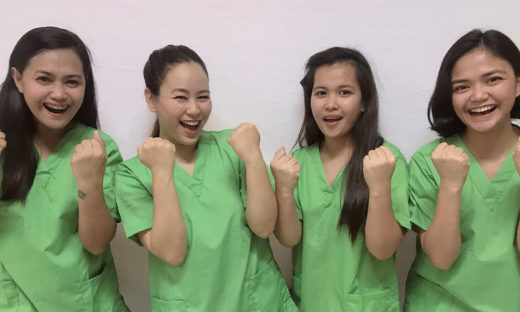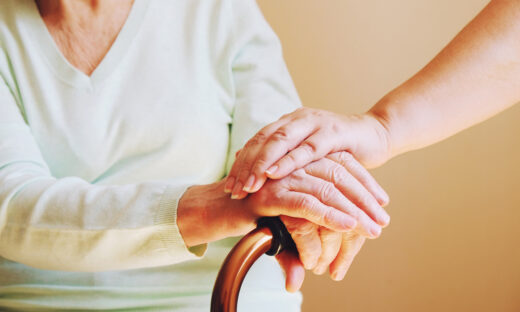介護実習生の一日の過ごし方@フィリピンの学校

日本企業に採用された介護の技能実習生は日本入国までにフィリピンの学校にて日本語や介護の勉強をします。
そんな彼ら/彼女たちの一日をフィリピンの学校の事務スタッフから紹介します。(翻訳付き)
“Minasan! Ohayou gozaimasu! Yoroshiku onegaishimasu!”
「皆さん、おはようございます! よろしくおねがいします!」
8:00 AM
Every morning, at exactly 8:00 AM, these words serve as an alarm clock to the people of San Mauricio Street. Located in San Juan City, Philippines is a well-known Training Center known as Yamahei. Yamahei Training and Assessment Center Corporation is an educational institution, accredited by TESDA, which is a home for students bound to work in Japan.
午前8時
毎朝8時丁度に、この言葉がサンマウシオ通りに目覚まし時計のように響き渡ります。Yamaheiはフィリピンのサン・ファン市にあり、素晴らしい研修施設として知られています。
These students with high hopes are about to spend their months in the institution and we will be giving you a glimpse of their daily routine. To start, just imagine dozens of students greeting each other to start their day.
この施設の生徒は、皆高い目標を持って数カ月間の研修を行います。少し、彼らの日常を覗いてみましょう。多くの生徒がお互いに挨拶をするところから1日が始まります。Yamahei Training and Assessment Center CorporationはTESDAの認定を受けた日本で働く生徒たちのための研修施設です。
8:05 AM
The students are now lined up in their own positions, waiting for the sound that would mark the start of their exercise. This daily activity also known as “Radio Taiso” is an exercise routine that has been practiced in Japan. It’s a very nice morning routine seeing students dance in rhythm under the projector’s light.
午前8:05
朝の体操を行うために、生徒は一列に並びます。日本の「ラジオ体操」を行います。プロジェクターのライトの下で生徒が一生懸命に体操をしている姿はとても微笑ましいです。
8:30 AM
After their daily attendance which is done thru Biometric Attendance System, the students are now ready to go to their respective classrooms.
午前8:30
生体認証の出席確認を終えたあと、生徒たちはそれぞれの教室へと向かいます。
Currently, there are two courses provided by the Training Center: The Basic Japanese Language and Culture Class, and the Caregiving Class.
現在、この施設には2つのコースがあります。基礎日本語と日本文化のクラスと、介護実習のクラスです。
The Basic Japanese Language and Culture Class are then divided into subgroups which is defined by their Level of proficiency. Yamahei has currently Four Japanese Language teachers or “Sensei/s”, this means we can accommodate up to four different classes, which is mainly composed of 15 to 25 students. This is where they learn Japanese Language, step by step. From Japan’s Handwriting System, known as Hiragana and Katakana, to Basic Vocabularies, N5 and N4 Lessons, and then Kanji Lessons. It usually takes up to 3 months before a student will be fully-equipped to take the “Accredited Japanese Language Proficiency Test, Level 4”. Might be a long time but our students can easily manage this since perseverance and patience are part of Filipino Culture.
基礎日本語と日本文化のクラスは習熟度別にいくつかのグループに別れます。Yamaheiには、現在4人の日本語教師がいるため、15~25名ずつのクラスを4つ作ることができます。これにより、生徒は各自のレベルに合わせて少しずつ日本語の勉強ができます。ひらがなとカタカナのレッスンから始まり、基礎的な単語のレッスン、日本語検定5級・4級の勉強や漢字のレッスンまで行います。日本語能力検定4級の受験まで、大体3ヶ月のレッスンが必要となります。3ヶ月は長いと思うでしょうが、フィリピン人には根気と忍耐があるため生徒達は問題なく試験に臨めます。
The second course is the Caregiving Class which is composed of students who already secured a Level 4 Japanese Language Proficiency Certificate. In this course, the students will be given basic knowledge about Caregiving. The training Center have a special facility, complete with different caregiving equipment which is perfect for their training. The training will take up to 2 months and the students will also be given a TESDA-Accredited Certificate. The exclusive part of this training is that they’ll be given Caregiving Training with specific Japanese Techniques. Currently, we have one accredited Caregiver Trainer, who had undergone a Trainer’s methodology and had also spent a one-month training in a Facility in Japan, and who is also an N4 Japanese Language Passer.
2つ目のコースは、日本語能力検定4級に合格した生徒で構成される介護実習クラスです。このコースでは、介護の基礎的な知識を学びます。研修施設には、介護の研修に適した様々な介護機器が備わっています。この研修は2ヶ月におよび、生徒はTESDAの認定証明を受けます。この研修の素晴らしい点は、日本方式の介護研修を行っていることです。現在、トレーナーの一人は日本の施設で1ヶ月の研修を受け、研修の方法論を納め、日本語能力検定N4も合格しています。
These are just some of the reasons why we are confident that we only produce competent graduates.
これにより、生徒は皆、優秀な成績を納めYamaheiを卒業生します。
10:00 AM
By this time, be ready to hear echoes of footsteps and greetings made by the students. They’ll be given 15 minutes to take their break. You can see some students taking their snacks, some are taking their chance for a quick nap and some are just glued to their notes. Either way, we make sure they have ample time to rest before getting back to their classes.
午前10:00
15分間の休憩です。生徒たちの軽やかな足音や、話し合う声が響き渡ります。おやつを食べたり、昼寝をしたり、授業の予復習をしたり、皆それぞれの休憩を取り、次の授業へと臨みます。
12:00 PM
One of the highlights of the day: the lunch break. The students have a maximum time of 1 hour and 30 minutes for their lunch break. This is their only time to prepare their meals, take their lunch and refresh. As part of their training, they are also being taught the Japanese Culture. This includes observing proper meal preparation, garbage separations and having “toubans”. If you’ll notice, even on their free time, the students are still in order and doesn’t forget Japanese Customs like their Aisatsu. During their meal time, the students can be heard saying “Itadakimasu” before eating as a way of complying with Japanese Culture. But Filipino Attitude are still noticeable; like little chitchats while eating, sharing of foods and having some extraordinary appetite. Might be a little weird but we believe that these make us more energetic and always ready to work.
午前12時
1日のハイライト、1時間の昼休みです。お昼ごはんを食べ、休憩をします。研修の一環として、「当番」を決めて、食事の配膳やごみの分別などを行っています。食事の前の「いただきます。」など、自由時間でも、生徒たちは日本文化の挨拶を忘れません。もちろん、フィリピン人らしく、お喋りしながらご飯を食べたり、食べ物を分け合ったり、大食いをする人もいます。日本の皆さんからすると少し変かもしれませんが、これが私達の元気の源です。
On their free time, you’ll see how disciplined the students are even there’s no sensei around. Even if an unexpected incident happens, the administration is ready to face this. Proper investigation shall take place and the Center will make sure that everything will be documented. An incident report shall be submitted with proper signatories and they’ll have a counselling with the persons involved to prevent reoccurrence of this issue. When a student incurred two incident reports, the said student shall be cancelled from the training program. This is to make sure that all students to be sent in Japan knows how to follow rules and regulations.
学校外の自由時間についても、施設側は生徒たちを見守っています。不測の事態が起きた場合も、我々は適切な対処をし、文書に残しています。関係機関に報告を行い、再発を防ぐために関係者とカウンセリングを行います。これは、日本に行くこととなる学生が、規則や規則に従えるかどうかを確認する方法ともなっています。
1:30 PM
The afternoon classes resume. This is where the students will start to do their activities related to their morning lessons. Oftentimes they’ll get written activities but there are also times when they need to do physical activities. These include dancing, singing and fun games. We believe these types of activities create a healthy environment. This is an advantage for our students since Filipinos are well-known for their lively and positive attitude.
午後1:30
午後のクラスが始まります。午後の授業で学んだことを活かした授業を行います。座学をすることもありますが、ダンス、歌、ちょっとしたゲームなどを交えたアクティブな授業を行います。フィリピン人は明るく朗らかな性格なので、生徒たちのやる気を起こすためにも役立っています。
3:00 PM
Proper life-balance means a lot to us, so we make sure our students will be given a fair amount of rest. Just like in the morning, they’ll also get a 15-minute afternoon break. Aside from the rest they’ll be getting, this also helps our students to become time-conscious. By implementing strict time schedule, the students are trained to be disciplined enough and avoid being late.
午後3:00
午前と同じく、15分間の休憩を取ります。適度な休憩は生徒たちの生活リズムにも適切です。また、休憩時間を設けることで、生徒たちの「時間を守る」意識の向上に繋がります。きっちりとした時間割によって、生徒たちは遅刻をしないようになります。
3:15 PM
Now back on their classes, the students have two more hours to complete the day’s study. They will use this time to review the lessons and check their activities. This is also allotted for the teachers to give their assignment which shall be submitted the next day.
午後3:15
授業再開です。これから2時間のクラスで1日の授業は終了となります。1日の復習をしたり、先生から宿題をだされたりします。
This will be their routine from Monday to Friday. On Saturdays, students will have their level up exam which will determine the class they should belong to for the next week. The passers shall continue with their current class level, while those who failed shall be moved to the lower class level. In this way, students will be encouraged to study harder and for the teachers to have proper study pacing.
以上が、生徒たちの平日の日課です。土曜には、次の週に受けるクラスを決めるためのレベルアップテストがあります。試験に受かった生徒は次も同じレベルのクラスを受講しますが、落ちた人は下のクラスに異動します。この方法は、生徒たちにとっては勉強への意欲向上に、先生にとっても授業の進行速度の目安となっています。
5:00 PM
It’s been a long day, but they have to do this all over again for the next day. Some might say it’s draining but nothing can beat a person who’s driven with grit. This is already proven since we have already sent a number of trainees in Japan. Some of them are already working there for years and they just kept on improving. That’s our students, that’s Filipinos.
午後5時
長い一日の終了です。明日も同じような1日がやってきます。人によっては、過酷だと言う人もいますが、努力は裏切りません。今までに何人もの実習生を日本へ送り出していることが証明です。何人かは既に日本で何年も働き、もっと上を目指しています。それがYamaheiの生徒であり、フィリピン人です。
The clock struck 5 in the afternoon, suggesting the end of the classes. We’re about to hear our favourite phrase again, reminding us how much we’ve worked hard:
“Minasan, domo arigatou gozaimashita! Otsukarasamadeshita!”
時計が午後五時の鐘を打ったら、今日の授業の終了です。私たちが今日どれだけ頑張ったかを思い出させてくれる、大好きなフレーズがまた聞こえてきます。
「皆さん、どうもありがとうございました!お疲れさまでした!」


















この記事へのコメントはありません。